SEAWOMEN
As the daughter of a flight attendant and a former sailor, I have been involved with the sea and transoceanic crossings since childhood. As an artist, I made my first trip aboard a ship in 2011, on a freighter from Varna, Bulgaria to Batumi, Georgia, followed in 2017 by a transatlantic voyage from Hamburg to Santos, Brazil, and later that same year as a passenger on a fishing expedition from Porto, Portugal. I then made a short film that I dedicated, along with the present text, to those women who worked on board the Hamburg container vessel.
The work of the female seafarer presents one of the starkest possible contrasts to the domestic working environment of the “housewife,” or to the social work often associated with female labor. Despite this fact, one thing these different work contexts share is their invisibility: the fact that these women go unseen by the public, and as grist for the mill of globalization and capital, perform underpaid, unrecognized, and often legally unprotected work. The anonymous, isolated, occult world of solitude on the seas was studied in great detail by Allan Sekula. [1] Despite his having focused so firmly – and maybe for the first time throughout art history – on the working conditions of modernized freight ships, the figure of the woman at sea plays no role and is thus entirely absent from Sekula’s research and films. The working environment at sea has been dominated by men for centuries, and it is only just recently that shipping companies such as MAERSK and Hamburg Süd have launched campaigns to recruit female crew members; still, just around one percent of this workforce consist of women, [2] for whom poor insurance and medical care, such as would be needed in the case of pregnancy, for example, make the profession extremely unattractive. [3] Up until the 2000s – and until 2016 in China – maritime training centers banned women from enrolling, even though requirements for physical strength have been minimized through digital navigation controls.
Still, there has been little if any description of working and living conditions in the male-dominated world of the sea vessel, where women are often regarded as intruders or, worse, as harbingers of misfortune. The omission of women seafarers is true both in the real working conditions just described, where few studies and associations work to assert women’s rights on board, as well as in fictional narratives and portrayals of shipping. The ship is a site of projection, and is rich with metaphors for art and literature; its secret society of men was often imagined as a game oscillating between crudeness and romanticism, an area of homosexual fantasies for sailors, including the harbor dive bars as imagined in the work of Jean Genet and Hubert Fichte. “What happens on board, stays on board” is a rule that still applies today – and one that I was informed of when boarding a cargo ship from Hamburg to Santos, Brazil in early 2017. This exhortation, legitimized as a sailor tradition, continues to inspire the imagination of those who remain ashore; in reality, however, it deprives workers of the right to legal recourse, which leads to the fact that many cases of discrimination and sexual assault by crew members go unreported. [4] There is barely any other place where superstition, sailor’s yarn, and romance collide so brutally with the facts of a working day at sea – a place where myths and stories are kept alive by the very workers themselves, perhaps as a means to help them endure the brutal working conditions their profession brings with it.
Working without daylight in the physically demanding engine room, it is the psychological strain of monotony that dominates. Surrounded only by the sea, one’s sense of time, proportion, speed, and distance is quickly lost. So it could be fair to think that for those at sea, the transition from reality to fiction is not a difficult one to make. But what is the role of women on board, in this in-between space? She deploys her own rules to penetrate into and open up the imaginary world of a Melville, occupied by men, leaving behind the roles ascribed to her as sex worker in the harbor, or as on-land marital partner/housewife for the man at sea.
Call me … it is with these words that the most famous novel about seafaring begins, that of Herman Melville. Initially opening up to readers an option for naming the narrator, he removes it in the same moment by proposing an unambiguously masculine name – Ishmael. How would that novel, and all other seafaring novels, have been received if Ishmael had carried a gender-neutral name or character? René Pollesch also remarked on this: in his play Black Maria, which recently premiered at the Deutsches Theater in Berlin, one of the actresses describes a staging of the classic novel Moby Dick as a prime example of the “empty stage” as defined by director Peter Brook – a space left for the imagination. She reminds us that for the audience, critics, and the director himself, the whale and the sea on the empty stage had appeared clearly before the mind’s eye. Perhaps, though, having the entire ship’s crew of the Pequod be comprised of eight actresses and not entirely of male performers would have challenged both the director’s and the public’s imagination.
On the other hand, women and the sea (not on the sea) have been the subject of many texts, as noted in Margaret S. Creighton and Lisa Norling’s study Iron Men, Wooden Women: Gender and Seafaring in the Atlantic World, 1700–1920 (1996). During the mid-nineteenth century’s golden age of seascapes and seafaring novels, there were some female authors who used the sea as a motif or metaphor, but who nevertheless perpetuated women’s roles as those who stay behind on the coast while men take to adventures on the high sea. [5]
The figure of the mermaid, on the other hand, represents a cultural and historically far-reaching link between women and the sea. She is the figurehead protecting the ship, or the goddess of the sea, as in, for example, the Afro-Brazilian religion Candomblé, where she bears the name Yemanjá. In the work of Friedrich de la Motte Fouqué, Henrik Ibsen, and Ingeborg Bachmann, the water creature Undine yearns to return to her own world of the sea. A sensitive creature with all the exuberant romantic qualities traditionally associated with the female sex and the astrological zodiac sign Pisces, Undine always struggles with her emotions. She longs for domesticity with a man but cannot escape her inner urge for freedom. In the end, with restrictions, freedom wins, as shown in Susan Sontag’s [6] late adaptation of the Ibsen drama The Lady from the Sea (1826). The play’s protagonist, Ellida, decides to stay with her husband, Hartwig, who had previously given her the freedom to leave whenever she wanted. Deflated and unsure of whether she has made the right decision, Ellida addresses this conflict: “I will just finish this last bit of embroidery and then I will get up and I will go to the sea and jump in. / Or better yet, I’ll take Hartwig down to the shore with me and point to the horizon to distract him and then smash his head in with a flat rock, and then I will jump into the sea and swim and swim …” [7]
In the middle of the nineteenth century, Hans Christian Andersen’s The Little Mermaid (1837) and Melville’s Moby Dick (1851) created two completely different perspectives on the sea. While the creature from the marine world wrestles in constructed romantic scenarios with unfulfilled love for a man on land, Captain Ahab and his crew vie for the attention of the white whale they follow through the oceans. As the motif of the ship as heterotopy is absent in the mermaid narratives, the comparison stumbles; nevertheless, it still shows the absence of a literature in which women would dominate both the male rules of the sea and those of the ship.
It is truly lamentable that even in more recent examples by female authors there is little encouragement for women to ride the seas. In Marguerite Duras’s novel The Sailor from Gibraltar (1952), a (very wealthy) woman is in command of a sailboat, but her justification and incentive for her adventures is to be found in her love for the titular deck boy. Here, too, the woman is not a seafarer in the truest sense of the word who has control over a ship, but a product of the first-person narrator: the fantasy of the “independent” adventure-seeking woman from a male perspective. Likewise, in Catherine Poulain’s latest novel Woman at Sea (2016), an initially promising story of a woman hired on board a fishing boat in Alaska quickly degenerates into romantic kitsch.
To do justice to that one percent of seafarers who are women, and to their working reality, we should perhaps look at the sea from new perspectives, tell new stories at a safe distance from cheesy romanticism, and honor the women, both in the engine room and on the bridge, who ship thousands of containers across distant oceans. While the opening up of maritime professions to women may in fact be the product of accelerated globalization, it nevertheless provides an occasion to rethink women at sea and their stories.
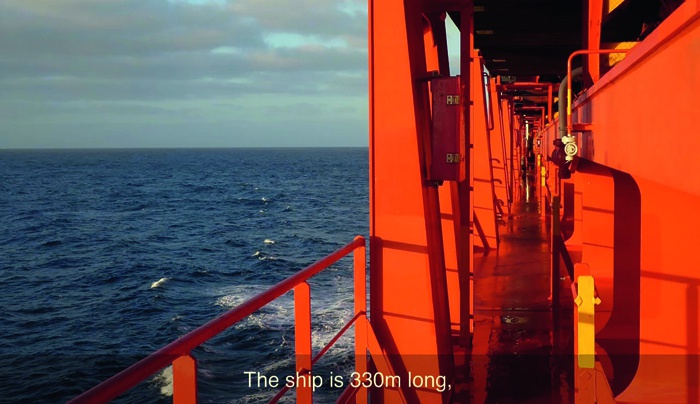

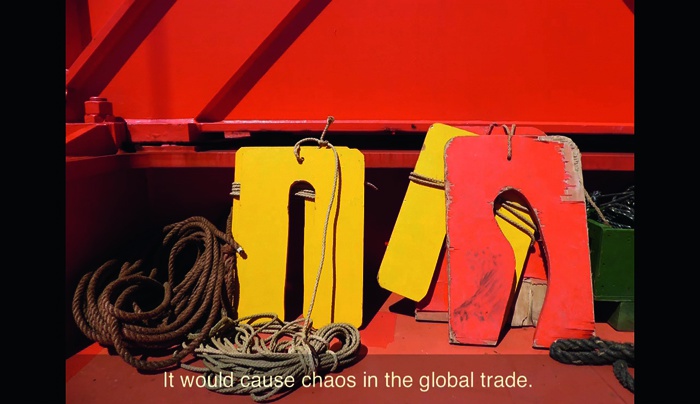


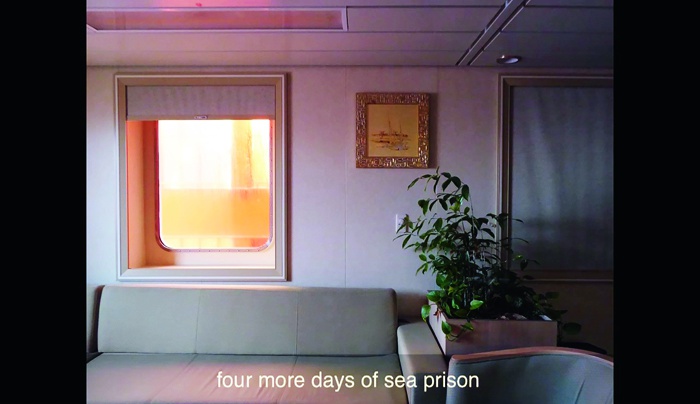
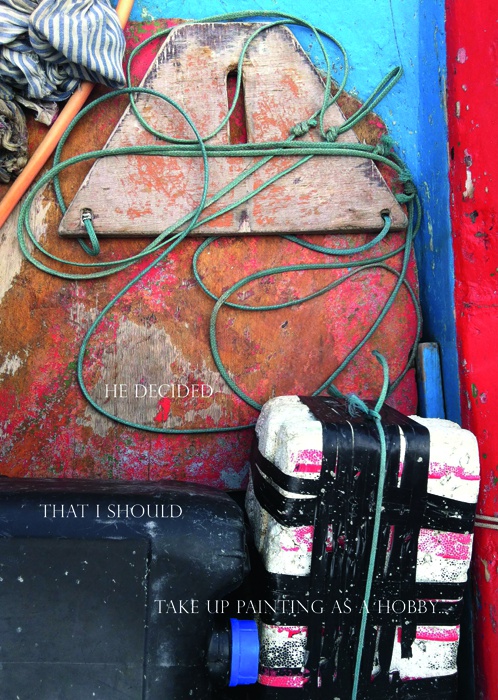
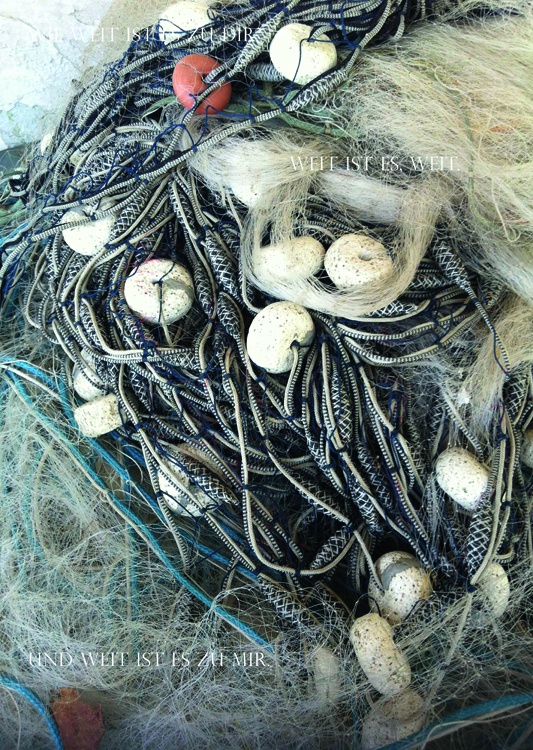
Translation: Matthew James Scown
Images: Bilder in abgedruckter Reihenfolge / images in the following order „Der Tag einer Seefrau an Bord / A Seawoman`s Day on Board“, 2017, film stills poster, Undine I (Susan Sontag „Lady from the Sea“) & Undine II (Ingeborg Bachmann „Undine geht“), 2017
Notes
| [1] | See Hilde Van Gelder (ed.), Allan Sekula, Ship of Fools/The Dockers’ Museum, Leuven 2015. |
| [2] | This text looks exclusively at cargo shipping, as the cruise ship sector is characterized by very different onboard conditions. |
| [3] | I have described the working conditions of women at sea more precisely in my film essay Der Tag einer Seefrau an Board (The Day of a Seawoman on Board, 2017). |
| [4] | See the report of the International Labour Organization, “Recruitment and Retention of Seafarers and the Promotion of Opportunities for Women Seafarers,” report for discussion at the “Sectoral Meeting on the Recruitment and Retention of Seafarers and the Promotion of Opportunities for Women Seafarers,” Geneva, February 25–March 1, 2019. |
| [5] | See Melody Graulich, “Opening Windows toward the Sea: Harmony and Reconciliation in American Women’s Sea Literature,” in: Margaret Creighton/Lisa Norling (eds.), Iron Men, Wooden Women: Gender and Seafaring in the Atlantic World, 1700–1920, Baltimore 1996. |
| [6] | Susan Sontag, “Lady from the Sea,” drama, first performed 1997. |
| [7] | Susan Sontag, “Lady from the Sea,” São Paulo, 2013. |
